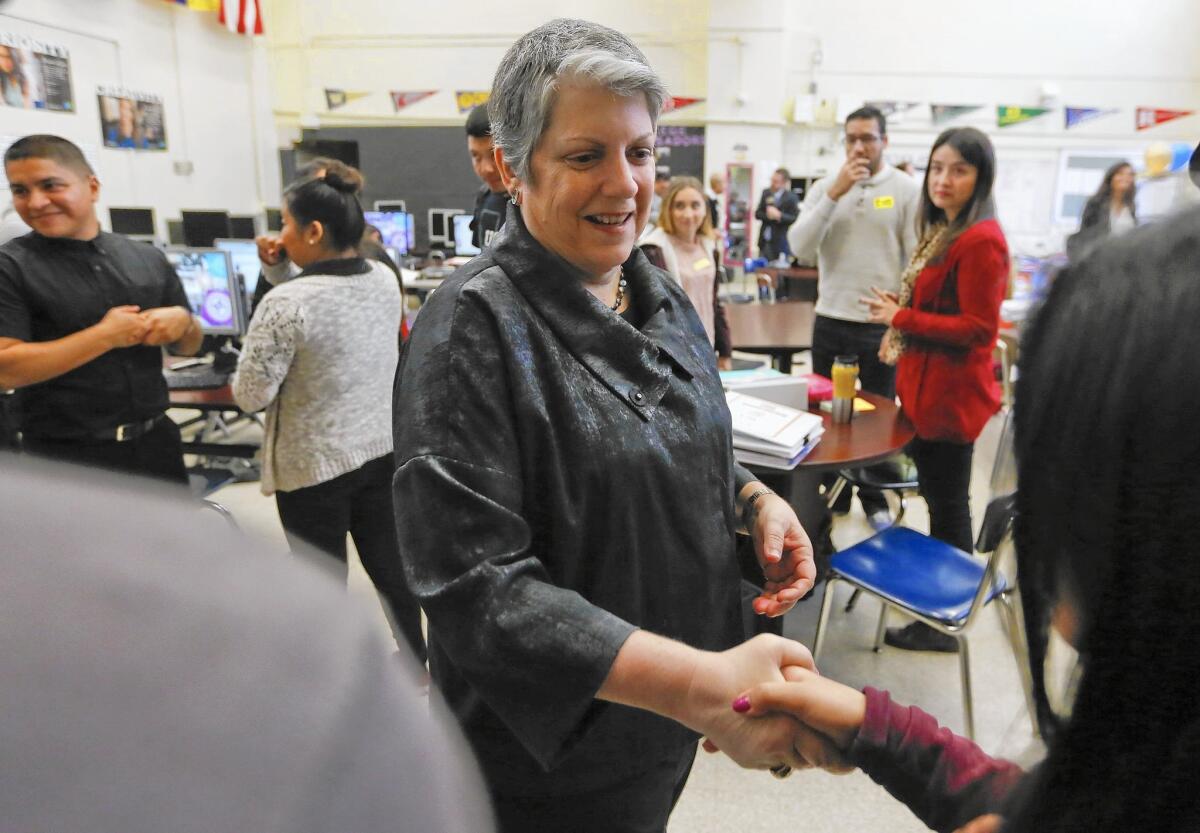UC expands its recruiting efforts targeting black and Latino students

UC President Janet Napolitano visits Manual Arts High today to make a recruiting push for more diversity
- Share via
The pitch came hard and fast: The University of California is the nation’s finest public system of higher education. Financial aid is aplenty. The commitment to diversity is strong.
The college recruiter who spoke Thursday to teachers, counselors, parents and more than 100 top students of color at Manual Arts High School should know her stuff. After all, she’s president of the 10-campus, 246,000-student UC system — Janet Napolitano.
The presence of such a luminary on this South Los Angeles campus of low-income, minority youth thrilled — and surprised — many students.
“She cares about underrepresented students and is really trying to help low-income students attend a UC,” said senior Alexis Neri. “I really didn’t know that before.”

Alexis is exactly the kind of student Napolitano wants to woo. He has a 4.1 grade-point average, nine college-level Advanced Placement courses on his transcript, accolades in five varsity sports, leadership activities and Mexican immigrant parents who pushed him to succeed even though neither attended college. He has applied to four UC campuses, along with several elite private universities.
Napolitano’s visit was part of UC’s expanded efforts to reach students who are still underrepresented in the system, particularly African Americans and Latinos.
UC officials are ramping up a pilot program that helped 12,000 students last fall learn how to prepare themselves to become competitive applicants, navigate the admissions process and access financial aid. The Achieve UC program will be expanded this spring to reach 60,000 additional students at 50 events at churches, career fairs and other venues. Ultimately, officials hope to make it a year-round program.
“We’re putting Achieve UC on steroids,” Napolitano said. “We want students and their families to know that a UC education is attainable and it’s affordable.”
Shortly after the 1996 passage of Proposition 209 barred the use of race and ethnicity in college admissions decisions, the proportion of black and Latino students at UC campuses took a well-publicized nose-dive. Achieve UC is the latest in a long series of outreach programs designed to increase their numbers.
The UC chief said she was stepping up recruitment efforts after noting that the number of black and Latino students at UC is still disproportionately low. Although the system is designed for the top 12.5% of California students, the share of black and Latino freshmen admitted to UC for fall 2014 fell thousands short of that goal, compared to the number of potential applicants.
African Americans made up 5.9% of the state’s high school graduates in 2014, but only 4.3% of those admitted to UC’s freshman class that fall; Latinos were 47% of California’s high school graduates but only 28.9% of those admitted.
In addition, while the number and proportion of Latino students have steadily increased at UC since 1997, the number of African Americans fell to 2,653 last year from 2,747 in 2013.
“I wasn’t happy with the numbers,” Napolitano added. “I thought we could do more. We should be more focused. We should put some real energy into this.”
The biggest misperception about UC, she said, is that it’s unaffordable to working-class families. And so she hammered home messages about financial aid in separate meetings with teachers and counselors, students, and their mostly Spanish-speaking parents.
The Blue and Gold scholarship will cover all tuition for families earning less than $80,000. The new UC Dream Loan program offers aid to undocumented students, who are ineligible for federal loans. About 45% of UC students graduate debt-free, and those who don’t end up owing less than $20,000 — a worthwhile investment, she said, that doesn’t depreciate the way a car does.
Napolitano also touted a program that helps community college students make a smooth transition to UC and told students that grades and standardized test scores are only two of 14 criteria officials consider in making their admissions decisions. As part of what they call a “holistic review,” admissions officers also ask whether students have special talents, contribute to their campuses or take care of their family.
The students peppered Napolitano with questions. Her biggest challenge? Getting more state funding. Role models? Her parents. Thoughts on Democratic presidential candidate Bernie Sanders’ call for fee-free college educations? “I don’t think it’s feasible,” she said. “I appreciate the sentiment ... but you’ve got to ask, who pays?”
Asked by an administrator who had applied to UC, several seniors raised their hands. It remains to be seen whether Napolitano’s personal visit will prompt them to enroll if accepted.
Ricardo Angulo, the school’s valedictorian who boasts a 4.6 GPA and leadership positions with the swim, robotics and academic decathlon teams, applied to four UC campuses. But for now, he said, he’s leaning toward USC, in part because of connections built with graduate students there who assist with robotics and other programs at Manual Arts.
Alexis has his eye on Harvard. But Napolitano still has a shot: He said funding to help him study abroad in France and do research in chemical engineering could nudge him to a UC school.
Twitter: @TeresaWatanabe
ALSO
It’s not just Hogwarts: J.K. Rowling reveals other wizarding schools
What happens to the $63 million if no one claims California lottery ticket?
How a Lincoln High teacher gets all his students to pass the AP Calculus exam
More to Read
Sign up for Essential California
The most important California stories and recommendations in your inbox every morning.
You may occasionally receive promotional content from the Los Angeles Times.














